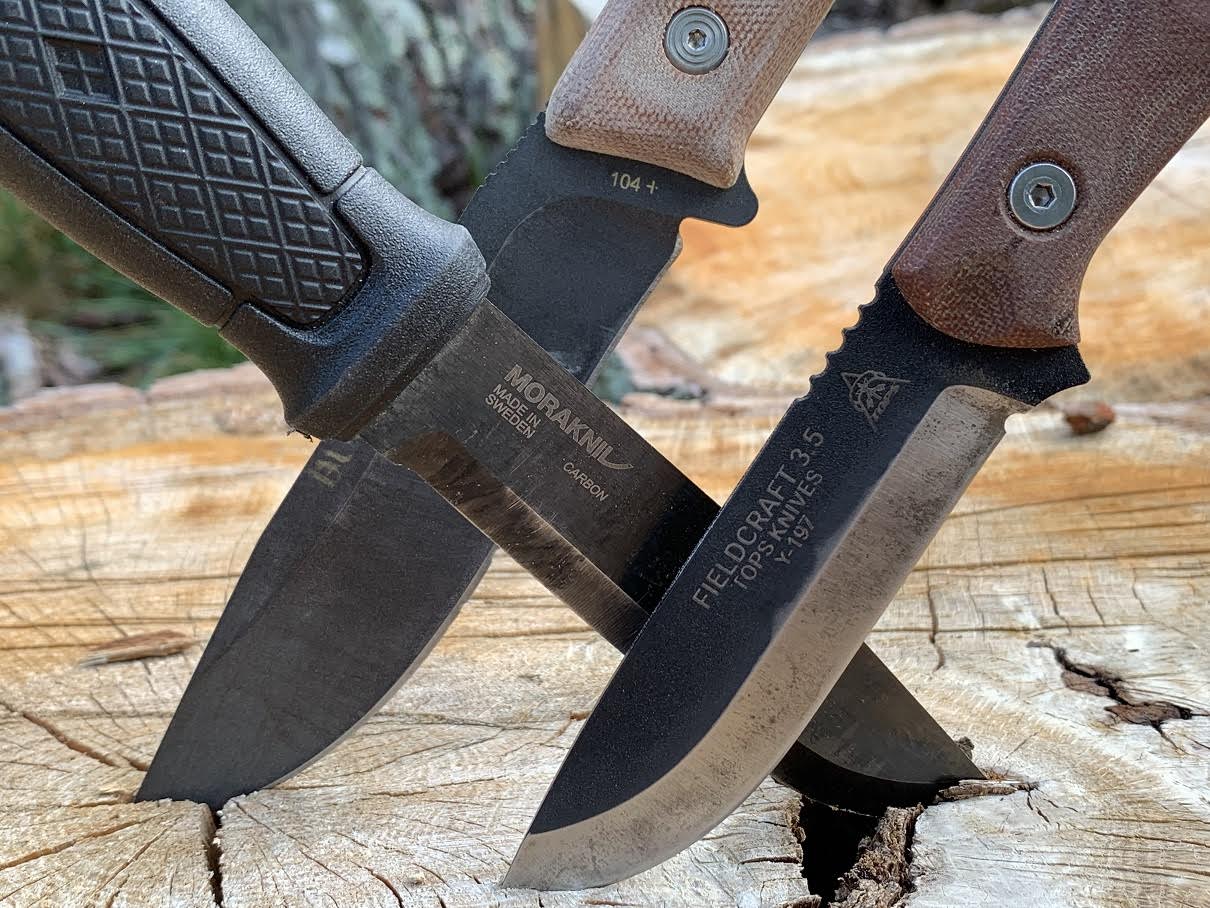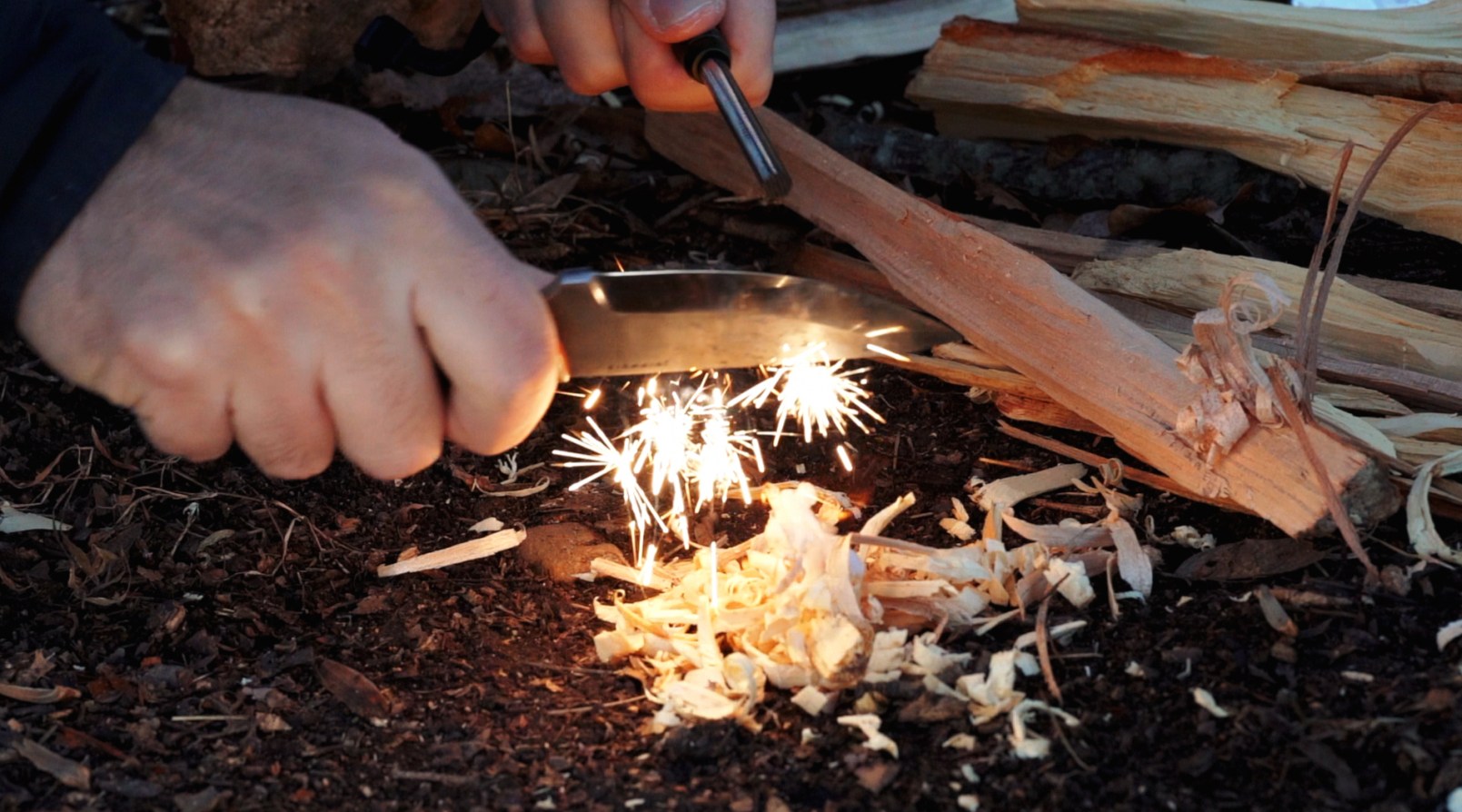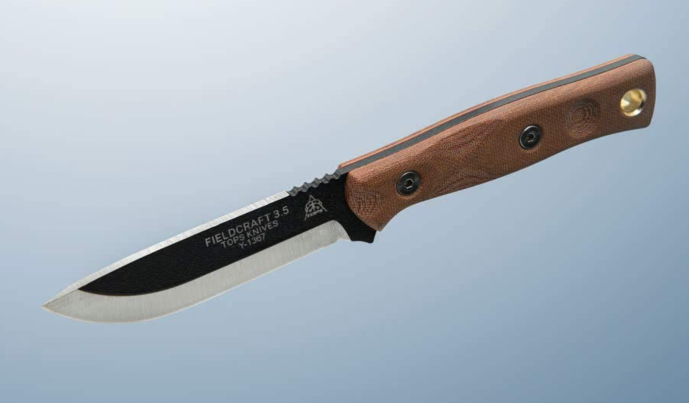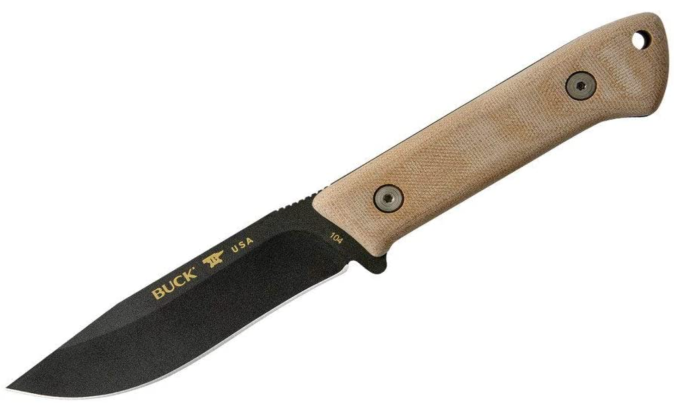We may earn revenue from the products available on this page and participate in affiliate programs. Learn More ›
So what is “bushcraft,” and why do you need a knife for it? The term “bushcraft” has been kicked around for decades, popularized by Britain’s Ray Mears and Canada’s Mors Kochanski. This word has always been synonymous with outdoor skills, but today, it’s getting even more traction in the self-reliance world. Bushcraft is the art of living in the wild, off the grid, and unfettered by modern technology. Since so many of these skills involve woodcarving, no other piece of bushcraft gear is as iconic (or as critical) as a good, dependable knife. So what makes a knife the best bushcraft knife? Let’s explore the necessary features before you buy some random shiny, sharp thing.
- Best Overall: TOPS Fieldcraft 3.5
- Best for Carving: Buck Compadre
- Best for Survival: Morakniv Garberg
Choosing the Best Bushcraft Knives
As a survival instructor, I’ve used a lot of knives and the ones that made my list for the best bushcraft knives are proven designs that I feel confident carrying.
The Best Bushcraft Knives: Reviews and Recommendations
Best Overall: TOPS Fieldcraft 3.5
Key Features
- Blade Length: 3.75 inches
- Cutting Edge: 3.63 inches
- Overall Length: 8.25 inches
- Blade Material: 1095 Carbon Steel
- Blade Thickness: 0.16 inches
- Blade Hardness: 56-58 HRC
- Blade Grind: Scandi
- Handle Material: Tan Canvas Micarta
- Sheath Material: Black Kydex
- Weight: 5.5 o ounces
- Made in the USA
Pros
- Easy to carry
- Durable
- Can be used for nearly all bushcraft tasks
Cons
- Handle could be small for large hands
The TOPS Fieldcraft 3.5 is a beautiful bushcraft knife with a balanced design. Even though it is made from very thick 1095 steel — 4mm thick, in fact — the lean profile keeps this tool relatively lightweight (5.5 ounces). The blade length isn’t gargantuan. It’s only 3.75 inches long, with an overall length of 8.25 inches. Though it’s still long enough to do smaller baton work and thick enough to take the abuse. While the handle is on the small side too, the brownish-tan Micarta handle scales create a comfortable grip and they hold a bonus feature for primitive skills enthusiasts. There’s a socket on each side of the handle, which allows the knife to be used as a friction fire socket for bow and drill fire starting.
In the two years that I’ve been using this knife on a regular basis, it has held edges well, and been almost immune to damage. The combination of thick knife stock and the Scandi grind edge didn’t let me down. From batoning and chopping to delicate carving, it’s an excellent “all purpose” bushcraft knife. And while the black Kydex sheath isn’t exactly primitive looking, you’ve got to love the positive click when it locks into place.
Best for Carving: Buck Compadre
Key Features
- Weight: 7.1 ounces
- Blade Length: 4.5 inches
- 5160 spring steel
- Micarta Handles
- Made in USA
Buck has been making quality knives for outdoor enthusiasts for over a century. The Buck Compadre continues this trend. Even without their iconic logo, you can tell that it’s a Buck. You can see the heritage of many other Buck knives in the curves of the Compadre. For this model, the 5160 spring steel blade is 4.5 inches long and 3.8 mm thick. With an overall length of 9.5 inches and natural canvas Micarta handle scales, the weight is a little heavy (coming in at 7.1 ounces), but this does give it enough mass for light chopping tasks. I am particularly fond of the way the knife feels in hand. The Micarta handle scales are well contoured for comfort and the knife spine has a great little section of thumb jimping near the handle. If you’re not familiar with this odd word, you probably know what it represents (jimping is the little grooves filed in a knife spine for additional grip).

Like so many Bucks, the Compadre is a hollow ground drop point knife. This isn’t the common pattern for bushcraft knives, but it works. Another unusual feature (different from most Bucks and many bushcraft blades) is the black Cerate Cobalt coating for corrosion resistance. I was initially concerned that this coating would drag during cutting, but that wasn’t the case. It cuts and carves very well, though the thin edge is more prone to impact damage than Scandi grind knives.
Best for Survival: Morakniv Garberg
Key Features
- Blade Length: 4.3 inches
- Blade Thickness: .13 inches
- Carbon steel blade
- Weight: 9.6 ounces
Pros
- Affordable
- Full tang
- A survival knife that can do bushcraft tasks as well
Cons
- Heavy
Maybe there’s something in the water in the industrial town of Mora, Sweden; but the blades that have been coming out of that city have become a bushcraft tradition. There’s just been one little problem over the years. Customers have been crying for thicker tangs and more robust blade construction. The Morakniv company answered this call, creating the Garberg — our pick for the best survival knife. With full tang construction, this 9-inch carbon steel knife has a 4.3-inch blade and weighs in at a beefy 9.6 ounces. While the knife profile, grind and handle swell may superficially resemble smaller Morakniv products like, the Morakniv Companion, this full-bodied knife is nothing like its puny cousins.
The black polyamide (plastic) handle could be a little rough without gloves, and it is a little jarring when doing impact work. Still, the Morakniv Garberg is ultra-durable and the black Multi-Mount sheath offers many options for carry. The MOLLE-compatible kit gives the user many different carry options. It also remedies a classic Morakniv problem: sheath retention. The Multi-Mount kit includes a strap that can hold the knife securely in its sheath. My initial tests went very well, and after several seasons of hard use, the Garberg is still holding up great, and it’s my pick for the best survival knife that excels at bushcraft tasks.
FAQs
For many years, Morakniv (and the two companies that predate the merger that created Morakniv) has been making laminated steel knives with an amazing edge geometry. This construction offers a high carbon steel center with stainless layers on each side. The carbon layer gives us easier sharpening and less brittleness, while the stainless exterior protects the core from rust and corrosion (and provides greater durability). Some “Mora” knives (like the Garberg) are closer to $100, but many are around $50 (like the Morakniv Bushcraft). If I had to be marooned somewhere with a $30 knife, I’d hope it was a Morakniv.
When you are ready to “live off the land” with your chosen bushcraft knife, I hope you have a sharpener in your bushcraft kit. While you may be able to use natural stones for knife sharpening (in certain areas), you may also find yourself in an area without the right stones for sharpening. The safest approach is simply to bring the necessary sharpening supplies with you.
This is a great question, and much of the answer depends on the manner of use. When doing fine carving, I prefer a thinner knife like the Morakniv Companion. It’s only 2mm thick, which may turn off many knife enthusiasts. The Companion is like a filet knife for wood, using finesse to cut instead of brute force. However, a blade that thin has very little weight (averaging 4 ounces, with the sheath), so it’s a poor chopper and a little sketchy to use for baton work. Something 3mm to 4mm thick would be a much heavier knife and more suitable for chopping and heavy work, though blades of this thickness don’t glide through the wood like a thinner blade.
How To Test Your New Bushcraft Knife

Can you baton with the knife? Is the knife good for chopping? And after all that, does the knife still carve effectively after performing brutal work? Before you end up deep in the backcountry with a wimpy knife, it’s smart to take the tool for a test run. Try making some hardwood kindling by striking the spine of the knife with a sturdy baton. This type of “bull work” has broken or bent countless blades over the centuries, but it’s also tested and proven countless knives since the dawn of the Iron Age. If your tool can survive this abuse at home, it’s very likely to survive the tough work it will face in the field. And if it still maintains a sharp cutting edge after the abuse, all the better. Try doing some fine work, like carving a feather stick after doing some baton work. Feather sticks are fuzzy pieces of kindling that are great for fire making in bad weather, as the curly shavings burn more easily than whole sticks. A tool must be sharp, however, to make these thin shavings. The knife that sails through both tests — especially performed back-to-back without sharpening in between — is a keeper.
How to Choose the Best Bushcraft Knife
While the best hunting knife is always a good backup, it’s not quite the same as a bushcraft knife. There are thousands of different knives that are commercially available today, but there are only two main things to consider then choosing a knife for a specific skill set (like bushcrafting): the blade construction and handle construction.
Pick the Right Steel
Back in the day, any self-respecting knife maker would pick the best metal available for tools as vital and versatile as knives. Today, many of the popular modern steel alloys used in commercial knife manufacturing will make a good sharp tool. Unfortunately, just being sharp isn’t good enough. The heavy toil of fieldcraft will require a blade that is hard enough to have good edge retention, while being soft enough that it isn’t brittle. I’ve long been a fan of 5160 spring steel for its insane durability, but this is hardly the only steel we might want. Stainless steel alloys might make more sense than high carbon steel, especially in coastal areas where salt corrosion is a greater threat to tools. You can also get the best of both worlds with laminated steel blades.
Edge Geometry
Beyond the steel used in the bushcraft knife, there’s something even more relevant to the effectiveness of a blade — the shape of the working edge. Edge geometry has always been a big deal in knife manufacturing, but educated consumers are also paying close attention to shapes and angles of knife edges. My favorite is a flat grind commonly known as the Scandi grind. This edge bevel is simple but very effective at wood carving. A typical Scandi grind edge angle is around 22 degrees (made up of two 11-degree bevels). This acute edge geometry acts a bit like a wood chisel. The edge bites into the wood and it carves more cleanly than most other edge types.
Get a Handle on Things
Whether it’s made from the finest Micarta or an old deer antler, the handle is the interface between the user and that tool. Being such a critical point of contact, the handle needs to be both comfortable and reliable. Tool handles should be secure and allow for a firm grip on the item. While I’d generally be happy with any handle construction that feels good in my hand, I keep going back to Micarta. This famous composite material was developed by George Westinghouse over a century ago, originally intended for use in electrical equipment and related applications.
More recently, Micarta has become a very popular material for knife handles. Various fibers and fabrics are used to make this special substance, along with thermosetting plastics. The result is a material that is durable and offers great grip without feeling rough to the touch. It also lends itself well to handle scales, which pair perfectly with our next point (full tang construction). If you are even thinking about performing heavy tasks with a knife, you’ll be in better shape with a full tang handle construction. The tang is metal — the part of a knife that extends into the handle. Some tangs are very slender, resembling a “square cut” nail. More robust tangs are the full height of the handle. With all that additional metal, full tang knives are heavier than thinner tang knives of the same dimensions. This additional weight, however, is usually worth carrying as full tang knives are much less likely to break at the handle junction or inside the handle (when compared to knives with a hidden tang).
Why Trust Outdoor Life?
Since 1898, OL has been a leading authority in testing and reviewing hunting gear, fishing tackle, guns and shooting equipment, and much more. We have more than a century-long history of evaluating products, and we’re now bringing that expertise to online reviews. Our editors are experienced outdoorsmen and women, and most importantly, we’re trained journalists. We prioritize field testing and objective data when reviewing products. We conduct interviews with gear manufacturers and engineers as well as outdoor experts so that our readers have an understanding of how and why a product works—or doesn’t.
Advertising does not influence our gear reviews and it never will. While we always focus our coverage on standout products—because we want our readers to be aware of the latest and greatest gear—we also cover the flaws and quirks of any given product.
Read Next: The Best Camping Knives of 2023
Final Thoughts on the Best Bushcraft Knives
In the quest to reconnect with our heritage, the growing bushcraft movement is full of enthusiasts who are rediscovering traditional skills and embracing age-old technology. I think it’s a wonderful and fulfilling pursuit, even if it does seem like we are stepping backward into history (rather than moving forward into the future). To make these skills even more fulfilling, it’s important to have the right tool for the job. Imagine a carpenter’s frustration, trying to saw with a hammer or trying to drive nails by banging them with a saw. You’ll need the right tool for the job, for the work to be effective and the experience to be satisfying. Yes, any knife is better than none when we spend time in the woods or the backcountry. But the right tool for the job will make the work much more pleasurable, and that’s what bushcraft is all about. We’re not stuck in the wild trying to stave off death, we’re going out into the wild to really live.
- Best Overall: TOPS Fieldcraft 3.5
- Best for Carving: Buck Compadre
- Best for Survival: Morakniv Garberg






